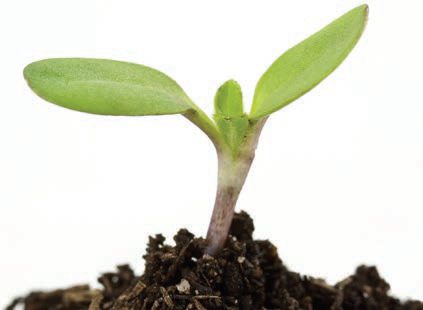Entomologist and IPM researcher, Dr. Michael Gaffney shares the latest research and thinking on the value and use of compost derived from existing waste streams in Ireland
In the last decade, a number of extreme weather events have placed significant pressure on field horticulture in Ireland, from freezing conditions and late springs, Intense rainfall and a lack of moisture around spring plantings have all caused significant losses in the field horticulture sector. Indeed, each year seems to present a new challenge. It is increasingly clear that we are not able to accurately predict the type and strength of these weather events, therefore we need to begin to put in place strategies to help improve the resilience of Irish horticulture, so we can better cope with the unforeseen. Improving the health of soils in field horticulture is one such strategy.
Under the European Landfill Directive (1999/31/EC), the amount of biodegradable municipal waste (BMW) going to landfill must not exceed 427,000 tonnes by 2016 (35% of BMW produced in 1995), with full diversion targeted for 2020. Ireland is on course to achieve these targets; however, currently, there are more than 800,000 tonnes of biodegradable municipal waste (food, garden, catering and commercial organic wastes) generated yearly, requiring treatment and ultimately a productive end-use. Composting is likely to be the most cost-effective form of treatment for these materials; however, a large proportion of this treated material is still returned to landfill. Composting reduces the volume of this material by approximately 90% and prevents the breakdown process becoming anaerobic, reducing the amount of phytotoxic compounds being produced, while also significantly reducing the amount of greenhouse gases emitted.
Composting organic household and industrial waste has many benefits over landfilling, (1) the composting process
“Research at Teagasc discovered a wide array of beneficial fungi and bacteria in composted waste samples, some which were capable of reducing the severity of both fungal and oomycete pathogens on vegetable crops”
reduces the volume of the material thus reducing the volume of waste, (2) composting is an aerobic process and therefore produces carbon dioxide where organic matter degradation in landfill is mainly an anaerobic process producing methane which has a greenhouse gas rating 20 times that of carbon dioxide, and (3) compost can be considered a resource and has the potential to be used as both a fertilizer and a horticultural growing media, as it contains both micro and macronutrients. Therefore it is a method of safely recycling waste back into the environment. Composted wastes are often thought of as either soil amendments or nutrient sources; however, they can also host an array of beneficial fungi and bacteria which can help to reduce the disease pressure on plants. Research at Teagasc discovered a wide array of beneficial fungi and bacteria in composted waste samples, some which were capable of reducing the severity of both fungal and oomycete pathogens on vegetable crops.
Composting has a pivotal role to play in closing the ‘organic loop’ – returning valuable organic matter and plant nutrients to the soil. To date, due to their high organic matter and lime content (2-11% dm), composted biowastes have primarily been considered as soil conditioners. However, their significant nutrient content (Table 1) means they also have a value as a fertiliser. Using composted wastes as fertilisers have been problematic however due to the heterogeneous nature of composts made from diverse waste sources (feedstocks) and the subsequent unpredictability of nutrient availability, due to a poor understanding of the effect of the primary feedstock on nutrient release. Within this study, composted wastes from Ireland and other European countries were analysed to ascertain the optimal usage of these materials, based on their compositional characteristics and primary feedstocks.
COMPOST STABILITY
In order for a composted waste to be marketed as a ‘compost’ and used in horticulture/agriculture, it must fulfill a number of criteria. An important criterion is that it must be ‘stable’, that is, the material is no longer microbiologically active. Under Irish standards, a material must have an oxygen uptake rate (OUR) value of 13 (Units: mmol O2/Kg OS/h) or less to be considered stable. It is hypothesised that unstable composts (<13) would immobilise nitrogen when applied to a growing media or soil, however, our studies indicate that such a rigorous standard may not be as appropriate for the land application. Biowaste composts used in this study with stability levels of 15-25 indicated no nitrogen immobilisation during plant growth studies, indicating that where composted wastes are destined for land application it may be possible to increase the stability standard required without negatively impacting plant growth, thus decreasing the time and cost of the composting process and in turn reducing the cost of these materials to growers.

NITROGEN AVAILABILITY
Carbon / Nitrogen ratio is commonly used as a descriptor of compost quality, but also as a means of predicting nitrogen (N) availability. Increasingly modern composting methods are producing composts with a C/N ratio of less than 16, as composts with a C/N ratio greater than 14 will potentially result in N immobilisation. Under the current legislation, composts with a C/N ratio <10 have a predicted availability of N of 15% and a C/N ratio of 12.5 having a predicted availability of N of 17.5%. However, this approach was largely developed for organic materials of a homogenous nature, such as spent mushroom compost. As the materials from waste sources are far more heterogeneous, it was found that both neural detergent fibre (NDF) and Lignin content were more accurate in predicting N availability from these materials (Table. 2). The ability to more accurately assess N availability will allow for the development of more agronomically useful application rates, which can account for the low availability of N from these materials. Overall the availability of N from composted biowastes is low (Approx. 8% of total N) and commercial growing practices would require the application of an alternative or inorganic N source. Plant growth experiments indicated that once the compost is moderately stable, plant uptake of N from inorganic sources was not affected.

PHOSPHORUS AVAILABILITY
In general, the plant uptake and availability of phosphorus from composted wastes from growth experiments was higher than expected and compared favourably with single super phosphate (SSP). While composted animal manures had the highest availability of P, there were no significant yield differences when biowastes were applied, on the basis of their total P content to plants whose phosphorus fertiliser was applied as SSP at a comparable rate. This finding suggests that instead of applying composts on the basis of their nitrogen content, which is largely unavailable to the plant, we should give more consideration to the phosphorus content of composted wastes.
In addition to the benefits described above in terms of nutrient recovery, applications of 5-10 t of compost per hectare per year have been shown to balance the yearly impact of intensive cropping systems, with long-term compost application increasing soil C content. As we are beginning to see the negative impact that extreme weather events are having, particularly on the field vegetable and nursery sectors, it is crucial that we begin to put in place measures to increase the resilience of our production systems. In the short to medium term, it is unlikely that we will be able to robustly predict which climate scenarios we will face (more/ less rainfall, intensity of precipitation etc.) therefore we need to do what we can to improve the resilience of our soils to these extreme events, and the consistent application of compost is one achievable mitigation strategy which we must seriously consider as the full utilisation of composted wastes can help maintain sustainable intensive cropping systems. ✽
 DR MICHAEL GAFFNEY is an entomology and IPM researcher working in the Horticulture Department in Teagasc, having previously worked at the University of Wales, Swansea and UCD. He leads a diverse research group focusing on crop protection and crop quality issues. He can be contacted at Michael.Gaffney@Teagasc.ie DR MICHAEL GAFFNEY is an entomology and IPM researcher working in the Horticulture Department in Teagasc, having previously worked at the University of Wales, Swansea and UCD. He leads a diverse research group focusing on crop protection and crop quality issues. He can be contacted at Michael.Gaffney@Teagasc.ie |





